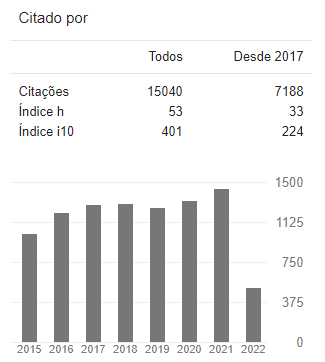Effects of a randomized controlled study on the behaviors of overweight schoolchildren
DOI:
https://doi.org/10.12820/rbafs.26e0221Palavras-chave:
Escolares, Excesso de peso, Atividade física, Comportamento sedentárioResumo
Este estudo objetivou analisar o efeito de uma intervenção multicomponente de base-escolar sobre os níveis de atividade física (AF) e comportamento sedentário (CS) mensurados por acelerômetro, de escolares com sobrepeso. Trata-se de um estudo controlado randomizado com escolares sobrepesados alocadas em grupo experimental (GE; n = 13; 7,6 ± 0,8 anos; 42,9% meninos) e grupo controle (GC; n = 17; 8,2 ± 0,9 anos; 26,7% meninos). O GE foi submetido a uma intervenção escolar de 10 semanas, composta por sessões de AF e psicológica (terapia comportamental) e orientação nutricional. O GC seguiu a rotina diária de vida. O tempo de AF e o CS foram medidos por meio de acelerômetros, utilizados durante sete dias. Para comparar o tempo médio de CS, atividade física moderada a vigorosa (AFMV) e atividade física total (AFT), foram utilizadas equações de estimativa generalizadas (GEE). Observou-se que o tempo médio em AFMV e AFT aumentaram significativamente no GE no fim de semana (+ 40,9 min / dia, p < 0,001; e + 51,6 min/dia, p = 0,035, respectivamente) e na semana inteira (+ 62,9 min / dia, p < 0,001; e + 225,0 min/dia, p = 0,038, respectivamente). Não houve diferença significativa no tempo gasto em CS após a intervenção em ambos os grupos. Assim, conclui-se que uma intervenção multicomponente de base escolar proposta foi eficaz no aumento dos níveis de AFMV e AFT em escolares com sobrepeso. Esse achado pode otimizar futuras intervenções em promover um estilo de vida saudável de crianças no âmbito escolar.
Downloads
Referências
Afshin A, Forouzanfar MH, Reitsma MB, Sur P, Estep K, Lee A, et al. Health effects of overweight and obesity in 195 countries over 25 years. N Engl J Med. 2017;377(1):13-27.
Gonzaga N, Sena A, Coura A, Dantas F, Oliveira R, Medeiros C. Sleep quality and metabolic syndrome in overweight or obese children and adolescents. Rev. de Nutr. 2016;29:377-89.
Wang YC, McPherson K, Marsh T, Gortmaker SL, Brown M. Health and economic burden of the projected obesity trends in the USA and the UK. The Lancet. 2011;378(9793):815-25.
Pereira S, Gomes TN, Borges A, Santos D, Souza M, dos Santos FK, et al. Variability and stability in daily moderate-to-vigorous physical activity among 10 year old children. International journal of environmental research and public health. 2015;12(8):9248-63.
Mushtaq MU, Gull S, Mushtaq K, Shahid U, Shad MA, Akram J. Dietary behaviors, physical activity and sedentary lifestyle associated with overweight and obesity, and their socio-demographic correlates, among Pakistani primary school children. Int. J. Behav. Nutr. Phys. Act. 2011;8(1):130.
Schneller MB, Duncan S, Schipperijn J, Nielsen G, Mygind E, Bentsen P. Are children participating in a quasi-experimental education outside the classroom intervention more physically active? BMC Public Health. 2017;17(1):523.
García-Hermoso A, Ramírez-Vélez R, Saavedra JM. Exercise, health outcomes, and pediatric obesity: A systematic review of meta-analyses. J Sport Sci Med. 2019;22(1):76-84.
Nooijen CFJ, Galanti MR, Engström K, Möller J, Forsell Y. Effectiveness of interventions on physical activity in overweight or obese children: a systematic review and meta-analysis including studies with objectively measured outcomes. Obes Rev. 2017;18(2):195-213.
Metcalf B, Henley W, Wilkin T. Effectiveness of intervention on physical activity of children: systematic review and meta-analysis of controlled trials with objectively measured outcomes (EarlyBird 54). BMJ: Br Med J. 2012;345:e5888.
Adom T, Kengne AP, De Villiers A, Puoane T. Association between school-level attributes and weight status of Ghanaian primary school children. BMC Public Health. 2019;19(1):577.
Nishtar S, Gluckman P, Armstrong T. Ending childhood obesity: a time for action. Lancet (London, England). 2016;387(10021):825-7.
Di Cesare M, Sorić M, Bovet P, Miranda JJ, Bhutta Z, Stevens GA, et al. The epidemiological burden of obesity in childhood: a worldwide epidemic requiring urgent action. BMC med. 2019;17(1):212.
IBGE. Pesquisa de Orçamentos Familiares–POF. Antropometria e Estado Nutricional de Crianças, Adolescentes e Adultos no Brasil. In: Ministério do Planejamento OeG, editor.: IBGE Rio de Janeiro; 2010. p. 130.
WHO. Physical status: the use and interpretation of anthropometry: report of a WHO Expert Committee. Geneva; 1995. 1995;854.
de Onis M, Onyango AW, Borghi E, Siyam A, Nishida C, Siekmann J. Development of a WHO growth reference for school-aged children and adolescents. Bull World Health Organ. 2007;85(9):660-7.
Migueles JH, Cadenas-Sanchez C, Ekelund U, Delisle Nyström C, Mora-Gonzalez J, Löf M, et al. Accelerometer Data Collection and Processing Criteria to Assess Physical Activity and Other Outcomes: A Systematic Review and Practical Considerations. Sports med. 2017;47(9):1821-45.
Engelen L, Bundy AC, Naughton G, Simpson JM, Bauman A, Ragen J, et al. Increasing physical activity in young primary school children — it's child's play: A cluster randomised controlled trial. Prev. Med. 2013;56(5):319-25.
Evenson KR, Catellier DJ, Gill K, Ondrak KS, McMurray RG. Calibration of two objective measures of physical activity for children. J. Sports Sci. 2008;26(14):1557-65.
Branscum P, Sharma M. After-School Based Obesity Prevention Interventions: A Comprehensive Review of the Literature. Int. J. Environ. Res. Public Health. 2012;9(4).
Mead E, Brown T, Rees K, Azevedo LB, Whittaker V, Jones D, et al. Diet, physical activity and behavioural interventions for the treatment of overweight or obese children from the age of 6 to 11 years. Cochrane Database Syst. Rev. 2017(6).
Golley RK, Hendrie GA, Slater A, Corsini N. Interventions that involve parents to improve children's weight-related nutrition intake and activity patterns – what nutrition and activity targets and behaviour change techniques are associated with intervention effectiveness? Obes. Rev. 2011;12(2):114-30.
Hu D, Zhou S, Crowley-McHattan ZJ, Liu Z. Factors That Influence Participation in Physical Activity in School-Aged Children and Adolescents: A Systematic Review from the Social Ecological Model Perspective. Int. J. Environ. Res. Public Health. 2021;18(6):3147.
Rhodes RE, Guerrero MD, Vanderloo LM, Barbeau K, Birken CS, Chaput J-P, et al. Development of a consensus statement on the role of the family in the physical activity, sedentary, and sleep behaviours of children and youth. Int J Behav Nutr Phys Act. 2020;17(1):74.
Craike M, Wiesner G, Hilland TA, Bengoechea EG. Interventions to improve physical activity among socioeconomically disadvantaged groups: an umbrella review. Int J Behav Nutr Phys Act. 2018;15(1):43.
Klingberg S, Draper C, Micklesfield L, Benjamin Neelon S, Sluijs E. Childhood Obesity Prevention in Africa: A Systematic Review of Intervention Effectiveness and Implementation. Int. J. Environ. Res. Public Health. 2019;16(7).
WHO. Recomendaciones mundiales sobre actividad física para la salud. Geneva: WHO Library Cataloguing-in-Publication; 2010.
Wahi G, Parkin PC, Beyene J, Uleryk EM, Birken CS. Effectiveness of Interventions Aimed at Reducing Screen Time in Children: A Systematic Review and Meta-analysis of Randomized Controlled Trials. Arch Pediatr Adolesc Med. 2011;165(11):979-86.
Friedrich RR, Polet JP, Schuch I, Wagner MB. Effect of intervention programs in schools to reduce screen time: a meta‐analysis. J. . Pediatr. 2014;90(3):232-41.
Tremblay MS, Aubert S, Barnes JD, Saunders TJ, Carson V, Latimer-Cheung AE, et al. Sedentary Behavior Research Network (SBRN) – Terminology Consensus Project process and outcome. Int. J. Behav. Nutr. Phys. Act. 2017;14(1):75.
Biddle SJH, Petrolini I, Pearson N. Interventions designed to reduce sedentary behaviours in young people: a review of reviews. Br. J. Sports Med. 2014;48(3):182.
Downloads
Publicado
Como Citar
Edição
Seção
Licença
Copyright (c) 2021 Revista Brasileira de Atividade Física & Saúde

Este trabalho está licenciado sob uma licença Creative Commons Attribution 4.0 International License.










